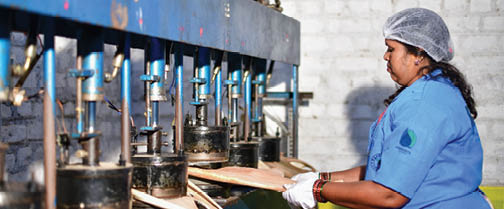Along with capitalizing on the momentum in the adoption of biodegradable tableware in Tier 2 and Tier 3 Indian cities due to local plastic bans and growing environmental awareness, Prakritii is rapidly expanding its global footprint by targeting Europe and the U.S. market. In an exclusive interview with Paper Mart, Mr. Vaibhav Jaiswal, Co-Founder and Director, Prakritii, shares how consumers’ rising demands and preferences for sustainable solutions, especially the corporate sector is accelerating mass acceptance of biodegradable tableware. This not only brings sustainability from ‘policy to plate’ but also redefines how natural materials are valued in everyday life.

Paper Mart: The plastic reduction movement has gained momentum through both regulatory action and consumer demand. Which force has a more direct impact on the momentum to reduce plastic waste? What specific event or market shift prompted your company’s strategic response?
Vaibhav Jaiswal: The consumer demand has had a more direct and enduring impact on the momentum to reduce plastic waste, even though regulatory actions have certainly played a catalytic role. Regulations often serve as the wake-up call but it is the rising eco-conscious consumers that truly drives sustained market change.
Over the last decade, we’ve observed a significant shift in buying behavior, where customers actively seek out environmentally responsible products, not just as an alternative but as a lifestyle choice.
A defining moment that prompted our strategic response was the 2019 announcement of India’s intention to ‘phase out single-use plastics’. While we had already been advocating eco-friendly solutions since our inception in 2010, this policy direction created a renewed urgency in the market.
Around the same time, international buyers—especially from Europe and the U.S.—also started demanding verified biodegradable and compostable products. This convergence of local policy shifts and global demand led us to expand our product lines beyond Areca leaf plates to include bagasse dinnerware, a paper-based solution, and bamboo cutlery, positioning Prakritii as a comprehensive eco-dinnerware brand.
PM: Your production relies specifically on Areca leaf. What quantifiable advantages for selecting this particular material, and how do you balance environmental claims against practical constraints like supply chain reliability and product performance metrics?
VJ: Prakritii’s choice of Areca palm leaves stems from their rare synergy of sustainability and strength. Sourced from naturally fallen leaves, Areca requires no tree cutting (deforestation) and decomposes in under 60 days, making it a zero-waste raw material. Each plate is crafted using water and heat, ensuring low-carbon, and a chemical-free process.
Functionally, Areca outperforms many biodegradable alternatives as it is sturdy, microwave-safe, and leak-proof. To balance environmental integrity with market reliability, Prakritii partners with farmer groups in Karnataka and Tamil Nadu, maintaining robust seasonal supply chains and diversifying into bagasse, bamboo, and paper to ensure scale without compromise.
Watch: In Pursuit of Lesser Water Footprint
PM: The terms ‘biodegradable’ and ‘compostable’ carry distinct certification requirements and yet are used interchangeably in the marketplace. How does your company address this distinction when developing products, and what impact this had on your certification strategy and manufacturing processes?
VJ: The distinction between ‘biodegradable’ and ‘compostable’ is critical and it is often misunderstood and used interchangeably.
At Prakritii, we educate our buyers and partners on the difference. ‘Biodegradable’ means the product breaks down naturally over time, while ‘compostable’ means to degrade into non-toxic components within a specific timeframe under set conditions. This clarity isn’t just semantic but it shapes our entire product development and compliance strategy. All our Areca products are 100% home-compostable, naturally breaking down in less than 60 days, without industrial intervention.
Manufacturing-wise, this means strict material traceability, chemical-free processes, and continuous batch testing to meet compostability benchmarks. It also influences how we label and market our products, favoring clear, certified claims over generic greenwashing.

For Prakritii, the most transformative advancement has been the development of a moisture-controlled, heat-pressing system for Areca leaves that ensures uniform thickness, increased durability, and a smoother finish, meeting international food safety standards while enhancing product aesthetics.
PM: Market adoption of biodegradable tableware appears driven by multiple stakeholders. Between corporate sustainability initiatives or B2B clients, consumer preferences, and regulatory frameworks, which segment has most meaningfully influenced the adoption in general and your sales growth in particular, and how has this mix evolved in the last few years?
VJ: While consumer awareness and plastic bans initially sparked interest in sustainable alternatives, Prakritii’s growth has been most meaningfully driven by B2B clients, particularly because of global retailers, hospitality groups, and brands with formal sustainability goals. These partners demand certified, scalable, and ethically sourced solutions, setting a higher bar for quality and traceability.
Since 2020, especially in the post-COVID era, institutional demand for hygienic, natural, and biodegradable packaging has surged —particularly in Europe and the U.S.—fueling consistent export growth.
During the pandemic, people increasingly turned to Areca leaf plates not just as dinnerware, but also as safe, eco-friendly options for packing prasad, dry fruits, fruits, chocolates, candles, and more, especially for gifting and festive occasions.
Today, as consumer demands and preferences increase, we’re witnessing a ripple effect where corporate adoption is accelerating mass acceptance, bringing sustainability from policy to plate, and reshaping how natural materials are valued in everyday life.


Tax incentives for manufacturers producing eco-friendly products could motivate more companies to transition to sustainable materials, making them competitive against cheaper plastic alternatives.
PM: The adoption of biodegradable tableware shows uneven development in terms of regions, industries, or buyer personas. Have you noticed any unexpected growth rate embracing biodegradable tableware faster than others? Which specific markets or customer segments have driven growth for your company, and what factors are accelerating their transition from conventional plastics?
VJ: While metros and export markets continue to lead, Prakritii has witnessed surprising momentum from Tier 2 and Tier 3 Indian cities, where local plastic bans and growing environmental awareness are driving rapid adoption.
Another unexpected growth pockets are the premium wedding planners and boutique caterers, drawn to the eco-luxury appeal of Areca dinnerware. Internationally, Scandinavia and Eastern Europe have embraced biodegradable tableware faster than anticipated, spurred by strict sustainability regulations and consumer demand for certified compostable products.
Across markets, it’s a mix of policy, perception, and purpose that’s accelerating the shift from compliance-driven procurement to values-based buying.
PM: Innovation in materials science continues to reshape production capabilities. What specific technological advancement—whether in raw material processing, manufacturing techniques, or product design—has most significantly enhanced your competitive position in this sector?
VJ: For Prakritii, the most transformative advancement has been the development of a moisture-controlled, heat-pressing system for Areca leaves. This innovation ensures uniform thickness, increased durability, and a smoother finish, meeting international food safety standards while enhancing product aesthetics.
Additionally, tooling upgrades in mold design have allowed for more intricate shapes and functional features, catering to evolving customer needs in hospitality and retail. These improvements have helped us scale without compromising on quality, positioning Prakritii as a premium, reliable brand in both domestic and global markets.
PM: Product development faces a fundamental tension between replicating plastic’s performance characteristics and redefining consumer expectations. Is your R&D primarily focused on matching conventional plastic properties, or are you investing in shifting market expectations about what tableware should deliver?
VJ: At Prakritii, our R&D team goes beyond replicating plastic, by rethinking and not just replicating. We aim to lean towards redefining our customers’ expectations about sustainable tableware.
While we ensure our products match key performance traits of plastic—like strength, leak resistance, and heat tolerance—we don’t aim to be a one-to-one replica. Instead, we focus on elevating natural materials as aspirational, not alternative. Our innovation lies in design, texture, and storytelling, making eco-friendly choices feel premium and intentional. By doing so, we’re not just competing with plastic; we’re changing the conversation around disposability, aesthetics, and responsibility.

Across markets, it’s a mix of policy, perception, and purpose that’s accelerating the shift from compliance-driven procurement to values-based buying.
PM: Even well-designed biodegradable products require appropriate waste management infrastructure. What specific infrastructure gaps most frequently undermine proper product disposal, and how is your company addressing these post-consumer challenges?
VJ: A key challenge for biodegradable tableware is the lack of adequate waste management infrastructure, particularly in emerging markets. Without composting facilities capable of processing biodegradable products, many product waste ends up in landfills, undermining their environmental benefits. To address this, Prakritii focuses on consumer education, encouraging proper disposal methods, such as home composting. We also actively promote waste segregation and its importance, and the need for robust local composting systems, to help ensure our products break down as intended.
PM: Functional composting systems remain inconsistent across markets. Can you identify a specific municipality, institution, or private operation that has successfully implemented end-to-end composting solutions, and what key operational elements make their system effective?
VJ: A standout example of successful composting implementation is the city of Indore, which has become a model for waste management in India. The municipality has established a comprehensive end-to-end composting system, featuring segregation at the source, community-driven composting hubs, and a centralized processing facility.
The system’s effectiveness is rooted in several key elements such as strong community involvement in waste segregation, regular education and awareness campaigns to ensure proper disposal, and significant infrastructure investment to handle biodegradable waste efficiently.
Indore’s approach highlights the potential for cities to create circular economies, ensuring that biodegradable products are composted properly and not lost to landfill waste.
PM: Policy support varies considerably across jurisdictions. What targeted regulatory change or incentive structure would most effectively accelerate your company’s growth trajectory? What specific barriers have prevented its implementation?

VJ: In terms of accelerating growth, Prakritii would benefit most from nationwide standardization of compostability certification and tax incentives for sustainable businesses.
Currently, the absence of uniform certification standards for biodegradable products creates confusion in the market and complicates international trade. A national framework for compostability certification, similar to those seen in Europe and the U.S., would streamline the process and boost consumer confidence.
Additionally, tax incentives for manufacturers producing eco-friendly products could motivate more companies to transition to sustainable materials, making them competitive against cheaper plastic alternatives. The primary barrier to these changes has been lack of coordinated policy enforcement and limited awareness among policymakers about the economic and environmental benefits of supporting the green economy.
PM: India’s manufacturing sector shows potential for global export leadership in biodegradable alternatives. Does your company plan to compete internationally, or the domestic scale and quality standardization issues are still the primary focus of your operational strategy?
VJ: At Prakritii, we are positioning ourselves for international leadership in biodegradable tableware, while ensuring that domestic scale and quality standardization remain foundational to our operations.
India’s growing reputation for producing sustainable alternatives positions us well for global export, especially in Europe and the U.S. markets where the demand for certified biodegradable products is high.
However, domestic market maturity still plays a crucial role. We continue to refine manufacturing processes, ensure quality compliance, and address the logistical challenges of scaling within India before pushing full-scale global expansion.
This two-pronged approach ensures that as we grow internationally, we’re backed by strong domestic foundations.
Also Read: Ecoware Sheds Light on Need for Comprehensive Ban on Plastic and Sustainable Packaging
PM: The five-year outlook for biodegradable tableware remains subject to debate. Does your company view these products as eventual complete replacements for conventional plastics, or as one component in a more diverse portfolio of sustainability solutions?
VJ: At Prakritii, we view biodegradable tableware not as an absolute replacement for conventional plastics, but as a key component in a broader sustainability solution. While biodegradable products like Areca plates offer a powerful alternative, the future of sustainable tableware will likely involve a mix of materials—biodegradable, compostable, and reusable—based on specific use cases and consumer needs.
We see innovation in material science and consumer behavior driving the evolution of eco-friendly solutions, where biodegradable tableware plays a crucial role but is complemented by other sustainable alternatives, such as recycled materials and multi-use products. The goal is to create a circular economy, where materials can be reused, composted, or recycled responsibly, and reduce waste across the board.



